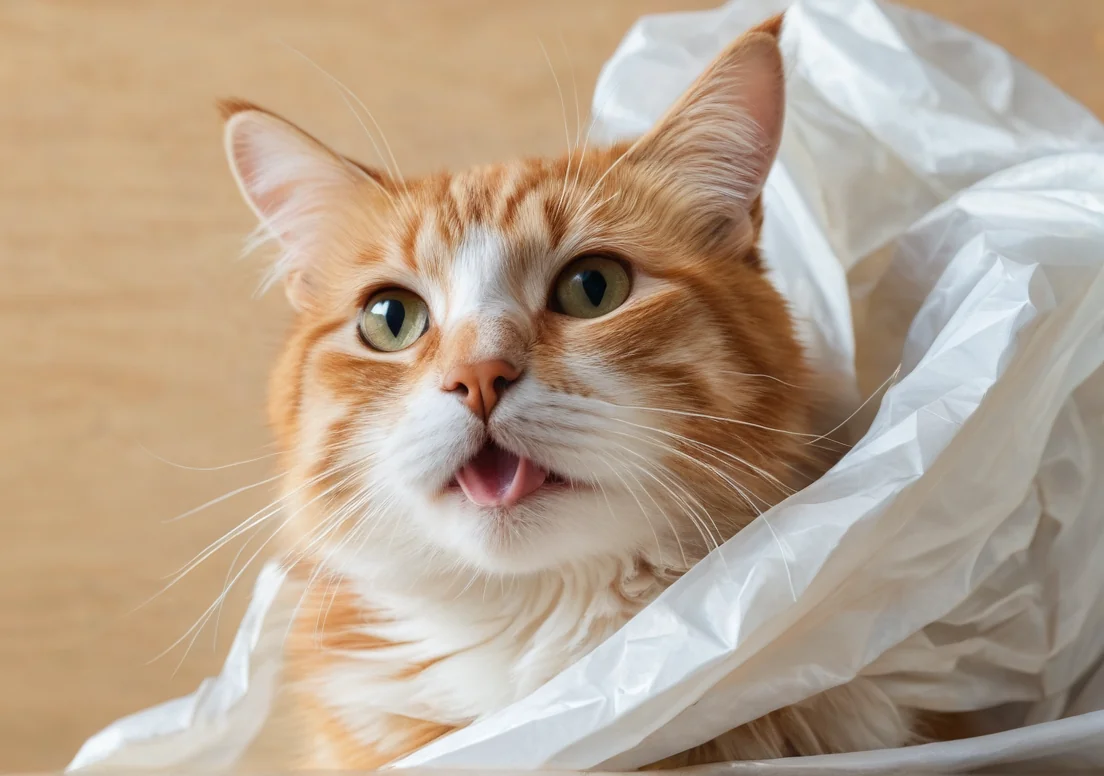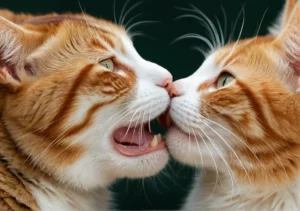Cats can be quirky creatures, often leaving us wondering about their odd behaviors. One of these oddities is their fascination with licking plastic bags, a habit that might seem perplexing at first glance.
The reason behind this behavior likely stems from their acute sense of smell and taste, combined with a natural instinct to explore their environment. Cats may be attracted to the scent of food residues on plastic, or they could simply enjoy the texture. But there’s more to this behavior than just a snack hunt; the reasons intertwine with their innate traits and personalities. You won’t want to miss the fascinating insights that follow!

What scents attract cats to plastic bags
Cats have an impressive sense of smell that’s anywhere from 14 to 18 times greater than ours. This keen olfactory ability draws them to certain scents found in plastic bags. Many plastic bags are made from materials that can retain odors from their contents, which might explain why your feline friend seems intrigued.
Food scents are particularly appealing. If a shopping bag previously held something enticing like chicken or fish, there’s a good chance it still carries remnants of those flavors, making it irresistible. Even the faintest whiff can trigger a cat’s hunting instincts, leading them to explore and, yes, lick that bag.
In addition to food scents, plastic can also retain residual pheromones from other animals. If your cat is sniffing around and lapping up a bag that once held items from a pet store or a friend’s house, they may be picking up on those delightful scents of fellow critters. Cats can be drawn to these smells similar to how they might react to a new friend’s scent in their territory.
Lastly, the scent of plastic itself can sometimes be appealing to cats. They might associate it with certain positive experiences, or they just like the mysterious nature of new smells. Understanding your cat’s fascination with plastic bags might just help you create a more stimulating environment filled with appropriate toys and snacks that unleash their hunting skills without compromising your shopping bags.
Is it the texture that cats enjoy
The texture of plastic is another compelling reason why cats can’t resist licking bags. The crinkly sound that plastic makes while your cat is exploring can be as engaging as a feather wand or a laser pointer. This sensory experience combines both sound and feel, creating an enticing and interactive experience.
Many cats are fond of textures that mimic what they encounter in their natural habitats. The smooth yet crinkly surface of plastic bags can resemble the rustling of leaves or various small prey animals, igniting their playful instincts. Some felines may even enjoy the slight stickiness of the plastic against their tongues, which feels unusual and intriguing to them.
Here are some specific textual features of plastic bags that cats find appealing:
- Crinkliness: The sound and feel stimulate their curiosity.
- Smoothness: It’s different from their usual grooming surfaces.
- Temperature: Plastic bags can feel cool, making them interesting to touch.
- Flexibility: Cats may enjoy how they can easily manipulate the bag with their paws.
Additionally, the act of licking plastic bags can serve as a form of self-soothing or stress relief. If your cat feels anxious or bored, the texture might provide comfort, akin to how we might fidget with something in our hands. Just be aware; while indulging in this behavior occasionally is generally harmless, it’s wise to monitor them to ensure they don’t ingest any plastic, which could pose health risks.
Do cats associate plastic with food
Cats have a knack for forging unique connections with their environment, and plastic bags can hold special significance for them. It often boils down to scent. Many grocery and treat bags carry remnants of food odors, making them prime targets for cats’ inquisitive noses. This might lead them to associate the smell of plastic with previous meals or tasty snacks.
Also, the crinkly texture of plastic can mimic the sounds of prey, further piquing your feline friend’s interest. The combination of scent and texture creates an enticing experience that may trigger memories of past feeding excitement. Thus, your cat may lick a plastic bag not just out of curiosity, but as a way of trying to relive the thrill of munching on something yummy, even if it’s just the memory of it.
Are there health risks in cats licking plastic
Cats licking plastic isn’t just a quirky behavior to observe; it can come with potential health risks. While a few licks here and there aren’t typically concerning, if a cat consistently chews on plastic, it could lead to some troubles, including:
- Intestinal blockages: Pieces of plastic can get stuck in their digestive tract, necessitating medical intervention.
- Choking hazards: Small bits may break off and pose a choking risk, especially if the cat gets too excited.
- Chemical exposure: Plastic can leach chemicals that aren’t safe for feline consumption, which might lead to health issues over time.
Be mindful of how much your cat engages with plastic bags. If you notice excessive licking or chewing, it might be time to redirect their attention or consult a vet.
An extra tip: to curb this behavior, try providing engaging toys or interactive feeders that stimulate their curiosity without the risks associated with plastic.
How does plastic bag licking relate to boredom
Cats often find themselves seeking out activities that keep them engaged, especially if they’re feeling bored. It’s not uncommon for a pet cat to look for interesting textures or scents to explore, and the crinkly sound of a plastic bag can be quite enticing. Licking plastic may provide a form of stimulation that’s absent in their environment.
If a cat licks plastic bags, it might be boredom manifesting in a quirky way. This could signal that your furry friend is craving interaction or more enrichment in their routine. When they chew or lick, they’re often trying to explore and find something novel in their day. Consider incorporating interactive toys or more playtime into their schedule to alleviate this boredom.
Some signs your cat may be bored include:
- Increased vocalization: If your cat is meowing more than usual, it might be looking for engagement.
- Destructive behavior: Scratching furniture or knocking things over can indicate a need for more stimulation.
- Lethargy: They might lounge around more if they don’t have anything to keep them active.
Addressing boredom can make a world of difference, so adding engaging activities could encourage them to divert their attention away from licking plastic.
Are all cats drawn to plastic bags
Not every cat has a fascination with plastic bags, but certain breeds and personalities might be more inclined to lick or play with them. For instance, Siamese and Bengal cats often possess a curious nature, making them more likely to investigate unusual objects like plastic.
In this context, individual personality traits can play a significant role. Some cats are adventurous and actively seek out new textures, while others are more reserved. Certain factors can influence this interest:
- Age: Kittens and younger cats are generally more playful and curious.
- Environment: Cats in stimulating environments with fewer distractions might resort to unusual behaviors like bag licking.
- Past Experiences: A cat that had positive interactions with plastic bags (like discovering food at the bottom) may be more attracted to them.
Understanding your cat’s unique personality can help you engage them better. If they love plastic, consider giving them safe alternatives, like crinkly toys, to satisfy that tactile interest without the risks associated with plastic.
Can licking plastic bags be a behavioral issue
Cats have quirky behaviors, and licking plastic bags might just top the list. While this could simply be a strange quirk, it can indicate deeper issues at times. Stress, anxiety, or boredom can drive a cat to seek out odd behaviors like licking plastic. If your furry friend seems overly fixated or engages in this behavior frequently, it might warrant a closer look.
Consider the possibility of pica, a condition where cats chew or consume non-food items. This habit can stem from nutritional deficiencies or behavioral concerns. If you’ve recently changed your cat’s diet or environment, these changes might trigger this behavior. It’s essential to observe whether this licking is an isolated occurrence or a consistent part of their routine. If it seems excessive or compulsive, consulting a veterinarian for tailored advice can be a wise move.
Keeping your cat engaged with interactive toys and environment enrichment can help curb this behavior. Creating a stimulating space can redirect their focus and keep those paws away from plastic.
What other unusual things do cats lick
Cats are natural explorers, and their taste-testing often involves some bizarre choices. Here’s a list of other unusual items that kitty might lick or chew on, accompanied by what these habits could mean:
Carpets : Cats sometimes lick carpets, possibly because of leftover scents or the texture. It can also relate to stress or boredom.
Human skin : If your cat licks you, it’s often a sign of affection. They see you as part of their family but can also be a way to mark their territory.
Metal : Cats may lick metal surfaces out of curiosity or to explore taste and temperature contrasts. If they lick metallic bowls, they may also be drawn to any food residue.
Plastic wrap : Besides bags, some cats like the texture or possible lingering food odors on plastic wrap. It can be a playful exploration of their environment.
Plants : If you notice them chewing or licking houseplants, they might be looking for hydration, but caution is needed as some plants can be toxic.
If your kitty’s licking habits become excessive or lead to gastrointestinal issues, it’s smart to consult a vet. Keeping an eye on patterns in their preferences can help you understand their quirky tastes and potentially address any underlying issues.
Trivia about cats and their quirky behaviors
Cats are notorious for their quirky habits, and the intrigue around why they lick plastic bags is just one of many behaviors that showcase their unique personalities. One fascinating fact is that cats have a keen sense of smell—up to six times stronger than humans. This heightened olfactory ability often drives them to investigate items in their environment, including those crinkly plastic bags.
Another interesting point is that many cats seem to have a thing for the sound of shifting plastic—some even find it comforting! This affinity often stems from associations with food packaging. After all, that rustle can remind them of tasty treats.
Moreover, it’s not uncommon for cats to exhibit pica, a behavior where they eat or chew on non-food items. Licking plastic might be a softer expression of this instinctive urge.
Here are some fun insights into cats’ quirky behaviors:
- Kneading: Cats knead with their paws, often when they’re feeling content or seeking comfort.
- Purring: While it usually signifies happiness, cats also purr to soothe themselves when stressed or unwell.
- Chirping: Cats may chirp when watching birds, potentially expressing excitement or frustration.
Think of these quirks as a peek into a cat’s unique perspective on the world. Understanding these strange behaviors can enrich your bond with your furry friend, helping you appreciate their individuality even more.
Alex, a passionate animal lover, has experience in training and understanding animal behavior. As a proud pet parent to two dogs and three cats, he founded AnimalReport.net to share insights from animal experts and expand his knowledge of the animal kingdom.




